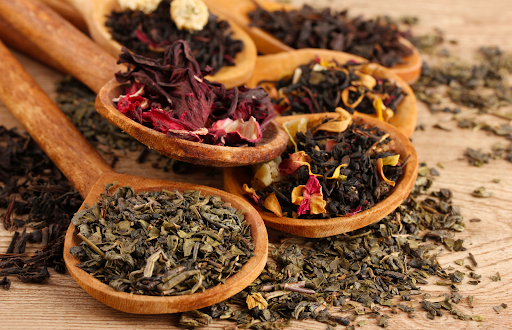Though the origins of tea are not confirmed, the most widely told tale is that in 2737 BCE, Chinese Emperor and herbalist Sheng Nung was having a servant boil drinking water when the leaves of a nearby plant flew into his drink, and he decided to try the infusion. For millennia after that, tea was drunk as a medicinal beverage before becoming a daily drink some time during the 3rd century CE. In 1610, the Dutch East India Company brought Chinese tea to Europe, and the British introduced tea to India in 1836. From there, the tea-growing industry expanded all over the world.
Tea leaves are classified in three ways: place of origin, size of tea leaves, and manufacturing process, with the most important one affecting flavor being the manufacturing process. The manufacturing process alludes to fermented (black), unfermented (green), or semi fermented leaves. Today, we’ll examine the differences between fermented and unfermented tea leaves.
Black (Fermented) Tea
The tea-making process can be broken down into four basic stages: withering, rolling, oxidation/fermentation, and drying. During withering, leaves are left out to dry until the initial moisture content of 70-80% per pound falls to somewhere between 55-70%, depending on the processing type. Traditionally, withering is done by placing the thinly spread tea leaves onto trays called tats and leaving them for 18-20

hours. However, with modern technology, we can reduce this withering time greatly, at the cost of lowering the quality of the final product. During the rolling stage, the dried leaves are rolled, either by hand or machine, so each leaf is coated evenly with juices and broken into pieces. The next stage, oxidation or fermentation, determines the tea’s color (thearubigin), taste (theaflavin), and strength. Oxidation occurs when a series of chemical reactions within the tea leaf create depth and change the flavor profile. In traditional processing, optimum fermentation is reached in 2-4 hours. In the final stage, drying, heat is used to dry the leaf to a moisture content of ~3% and caramelize the sugars in the leaf, giving it its final black color.
Black tea and other fermented teas are usually characterized by their bright tea infusion, unique aroma, and sweet and smooth taste with low levels of bitterness. Depending on the fermentation process, black tea can have malty, fruity, or even smoky notes. It is the most widely consumed type of tea in the world.
Green (Unfermented) Tea
Green tea is a completely unfermented tea, which means that tea makers stop the fermentation process by semi-blasting it with hot air or heating it in a hot pan to kill the oxidized enzymes before the rolling process. Because there is no oxidization of the enzymes in the leaves that turn them a black color, the leaves retain their characteristic green color when they are finally dried to a moisture

content between three to four percent. The lack of oxidation in these enzymes gives green tea a milder flavor than black tea. However, some green teas have stricter and more complicated creation processes, one of which is Japanese matcha.
The tea leaves for Japanese matcha are always taken from buds and the top three layers of shade-grown tea plants, due to their higher levels of chlorophyll being indispensable to the end matcha product. After these leaves are picked, the oxidation process is stopped by steaming the leaves. The veins of the leaves are then removed before they are ground into a fine powder. This labor-intensive process makes matcha powder more expensive compared to other teas.
Modern Variations of Tea
Bubble Tea

Due to its recent rise into the mainstream through tourism and social media, most people know bubble tea as the classic milk tea with dark brown tapioca pearls, and for the large part, they’re right⸺but it didn’t start that way. Early bubble tea was a much more average-looking drink, made in a cocktail shaker and with green or black tea, sugar syrup, ice, and no tapioca pearls. The shaking method would create a layer of froth on top of the drink, much like a “head” on a pint of beer, and was originally done by hand whereas nowadays most places use machines to shake their tea. In the late 1980s, tapioca pearls were added to the drink, transforming it into what we know as bubble tea today.
After that, many places have deviated from the milk tea and tapioca pearl combo and added juices, various fruit jellies, and popping boba pearls. Nevertheless, people’s love for bubble tea has remained despite the changes in ingredients and creation methods.
Sweet Tea
Sweet Tea is a Southern classic, and for good reason. The drink is around 22 percent sugar, which is double what’s put into a can of

Coca-Cola. Pair that with the ease at which the average person can down another glass of sweet tea and we start to see why the drink is so popular. That being said, the history of Southern sweet tea truly is the embodiment of American history.
The history of Southern sweet tea begins with the importation of tea plants to the Summerville, South Carolina area by French explorer and botanist Andre Michaux, but the first recipe to resemble what we consider ‘Sweet Tea’ wasn’t printed until 1879 in “Housekeeping in Old Virginia”, a cookbook by Marion Cabell Tyree. Then, due to people hunting for new drinks to replace alcohol during Prohibition, sweet iced tea cemented its place as a Southern staple, with societal women and churchgoers creating their own takes on the drink. In 1995, South Carolina made sweet tea the state’s official hospitality beverage.
Local Recomendations
Northville Tea and Spice Merchants

Northville Tea and Spice Merchants is a small shop in downtown Northville that sells loose-leaf teas and spices from all over the world. As soon as you walk in, you’ll be shocked to find the walls covered with different spice blends for you to choose from, and don’t be afraid if you’re a loose-leaf tea newbie, because the shop also sells teapots and anything else you’ll need to get started on finding you favorite blend. The store also has a range of black, green, herbal, white, and oolong teas, for you to try out.
The entire store has a very warm atmosphere, with toasty cedar wood and a friendly staff. And the best part is that it’s close by. You can find Northville Tea and Spice Merchants in downtown Northville, at 134 E Main St, Northville, MI 48167, or on their Facebook page, where they post recipes using their spices and advertise new blends like their Honolulu Blue Brew, with an electric blue color and notes of Butterfly Pea Flowers, white pineapple, and blueberry sugar. Give it a try if you are feeling adventurous.
Kung Fu Tea

Kung Fu Tea is a chain of bubble tea shops in the United States founded in Queens, NY on April 30, 2010. They are America’s largest bubble tea brand with over 350 locations nationwide; the closest location can be found at Fountain Walk Plaza in Novi.
To many, Kung Fu Tea is a staple boba place, with a wide variety of customizable options. Kung Fu Tea caters to those with different tastes with everything on their menu from icy slushes to espresso and milk tea options. Past that, you can choose any topping you want from tapioca pearls, flavored popping boba, pudding, fruit jellies, and more. But what sets Kung Fu Tea Novi apart from its competitors is the social aspect of the shop. The walls are covered with vibrant colors that fit Kung Fu Tea’s branding and they offer plenty of games for their customers to play, making it a social staple for bubble tea lovers.
Sweetwaters Coffee & Tea

You probably aren’t going to get anything close to authentic Southern sweet tea in Michigan, so many people’s next-best option for their sweet tea fix is Sweetwaters Coffee & Tea.
Unlike Northville Tea and Spice Merchants or Kung Fu Tea, the Sweetwaters location in Novi has a chic look, with tall white walls and mostly tables for two, making it a perfect small get-together spot. If you’re looking to work on a school project or talk with a larger group, there’s also a larger table in the back, but sometimes it’s taken. Nevertheless, Sweetwaters has a great sweetened tea collection, with plenty of premium or signature teas for you to try out, like their Imperial Milk Tea inspired by Hong Kong teahouses, or their Greek Mint herbal blend if you want a smoother tea.
Sources
- Black Tea Processing | Britannica
- UK Tea & Infusions Association – History of Tea
- How Is Tea Made – All About the Process – Twinings
- Modulation effects of microorganisms on tea in fermentation – PMC
- What Is Black Tea?
- The Number One Tea in the World: A Cultural and Historical Journey
- Who invented bubble tea? – Taipei Times
- Origins and Timeline of Boba — Sharetea – Best Bubble Tea Brand
- How Summerville Became the Birthplace of Sweet Tea in the States
- A Southern Treat: The History Behind Sweet Tea | Royal Cup Coffee
- Learn how the South became synonymous with sweet tea
- Here at Kung Fu Tea, we believe that it’s our mission to not only continuously improve our brand and beverages and the lives of our customers through providing only the most delicious, high-quality flavors but also to inspire the community to dream big and live fearlessly
- Asian-Inspired Tea Menu







